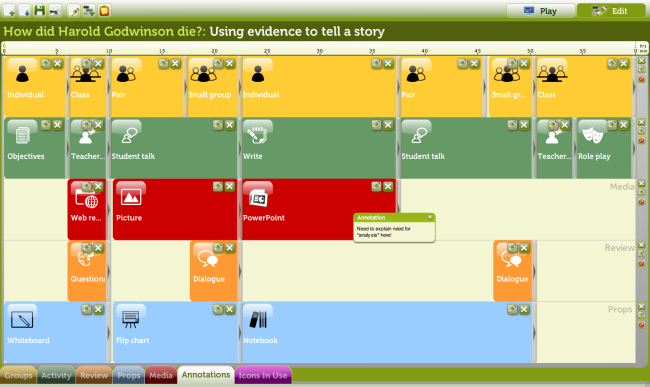Learning Score, a lesson-planning tool. [Review]
Full disclosure: after mentioning Learning Score in a previous post (and raving about its potential) I was kindly given a free copy of the latest version, courtesy of John Davitt and Tribal. This was done on a no-strings-attached basis and does not influence the positive or negative points I make below.
Introduction
Lesson planning is a difficult thing to learn to do well; it’s even more difficult to teach others to do effectively. The idea of coming up with learning objectives and success criteria before dealing with specific activities is a difficult one to get used to. And then there’s all of the other things to get right:
- Timings
- Transitions
- Managing resources
- Homework
The list goes on…
Overview
So that’s why I was overjoyed (yes, overjoyed) when I saw Learning Score. It’s described as a multi-media lesson planning and delivery tool and I believe it to be invaluable for:
- Planning your own lessons
- Sharing your lessons (and associated resources) with others
- Modelling good practice
As you can see from the video at the top of this post, it’s extraordinarily intuitive and easy-to-use. The metaphor used is a musical score, a perfectly befitting one as a well-planned and executed lesson is like beautiful music played by a symphony. 🙂
In an improvement from the previous version, you can add up to 6 tracks, meaning that you can rectify the strange situation where ‘props’ are available to be added at the bottom of the screen but, by default, there’s nowhere to put them!
You create your lesson in ‘Edit’ mode and then, when ready for delivery (and after saving, of course) you click ‘Play’ to enter delivery mode. This has a timer function to keep you on track, but to be honest I find that learning goes off at so many tangents sometimes that the lesson plan is merely a statement of intent. The timer’s not that useful to me, but may be to trainee teachers for reassurance.
Double-clicking on the resources in ‘Play’ mode allows you to view/listen/access them within Learning Score. For obvious reasons, the filetypes available are limited. With videos, for example, only SWF and FLV files can be used. If you’re fond of using downloaded YouTube clips, this presents no problem at all. If you’ve got a bank of high-quality MP4 files, on the other hand, you’re going to either have to get transcoding or play them outside of Learning Score.
Positives
I love the whole concept of Learning Score: the way that it liberates you from having to use just text, which often can constrain ideas – and therefore creativity. I really like the way that, if you choose, you can package up all of your resources inside Learning Score, ready for delivery. And then, again if you choose, export them, share them with colleagues, or add via SCORM-compliance to your schools’ Learning Platform.
I admire the powerful simplicity of Learning Score, the way in which you can very quickly build up a lesson by focusing on learning rather than just keeping students busy. I find the interface intuitive, fairly lightweight and flexible. I like the ability to add annotations. In short, if a site is created to be able to share the resulting .lsz files (I’ve been told it’s in the works) then I can see Learning Score taking off. Big style. 😀
Areas for development
But Learning Score isn’t perfect. There are still some things I’d like to see improve. For example, although I can customise activities and props after dragging them onto the score, I haven’t figured out a way of adding to them so that they appear by default. And having only 30 characters for the main learning objective is nowhere near enough!
My second problem is the proprietary nature of the file format it produces. To a great extent this is the nature of the beast: it’s a new, fairly revolutionary tool. But the ability to read and write the file formats using (potentially) other applications would be a boon. It would reassure me as an educator that I’ll always be able to access my own lesson planning in future.
And finally, although the whole point of Learning Score is lesson planning and delivery in a very visual and multimedia kind of way, sometimes it’s necessary to print things out. Unfortunately this is what a wonderfully-crafted and visual Learning Score looks like when exported to text format ready for printing. Not pretty.
Conclusion
I highly recommend Learning Score. It’s an application that, had I not very kindly been given a free copy, would definitely have purchased for myself. It not only serves as an awesome way to plan your own lessons (and meetings, projects…) but to demonstrate in a very hands-on, visual way how colleagues and trainee teachers can do likewise!
- Learning Score >> free trial
- Tribal shop >> purchase

